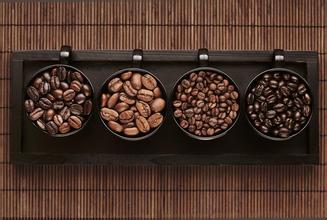The altitude of coffee beans the difference between cocoa beans and coffee beans
The altitude of coffee beans the difference between cocoa beans and coffee beans
To put it simply, the higher the altitude at which coffee beans grow, the better they taste. Coffee beans grown at high elevations have pleasant acidity, rich aroma and rich taste, which everyone likes; on the contrary, coffee grown at low elevations has almost no sour taste, single taste and plain taste. That's why baristas always emphasize altitude. If your barista tells you that your coffee grows on a plateau 5200 meters above sea level, then this cup of coffee is definitely worth savoring.
Although altitude is only one of the many factors to measure the quality of coffee, it is definitely the most important one. The next time you go to the coffee shop, please ask the barista to tell you the history of the coffee in the cup, which will not only enrich your coffee knowledge, but also improve your overall coffee experience altitude, which will directly affect the appearance of coffee beans. When you take a closer look at raw coffee beans, you will find that the size and density of each kind of coffee are different. Are the coffee beans in your hand small and dense? Is the gap in the middle of the bean tightly closed or open? Is the gap straight or curved? Is the color of coffee beans close to jade, light green or blue? The shape characteristics of the bean body can directly reflect the growth altitude of coffee beans.
The best quality coffee beans are usually strong and grow at an altitude of more than 4500 meters. The growth of these coffee beans is very slow, so the density of the beans is very high, and the gap in the middle of the beans should be curved. In contrast, coffee beans grown at low elevations usually have a lower density and slightly open gaps in the middle. As for the color of the bean, the growing environment of the coffee bean and the processing technology of the raw bean will affect the color of the coffee bean. If the same kind of coffee beans produced on the same plantation are treated differently, for example, one batch is washed with water and the other batch is treated with honey, then the colors of the two batches of beans will be very different. Generally speaking, the density of bean body is the most powerful basis for judging the altitude of coffee bean growth.
Defective beans are an important factor that destroys the flavor of the final coffee. Therefore, defective beans should also be removed in the last step of raw bean processing. This has the problem of the number of defective beans, so according to the proportion of defective beans, supplemented by the size of the screen is also a way of classification.
Due to the rise of boutique coffee, coffee producing countries pay more and more attention to the quality of coffee, and the control of defective beans is the most important way. therefore, basically using the defective bean proportion as the classification method or auxiliary basis is becoming more and more popular. at present, the main representative countries that use defective bean proportion method are Jamaica, Brazil, Ethiopia and so on. Jamaica is based on the comprehensive rating criteria of producing area, altitude, screen, and defective bean ratio. For example, Jamaica Blue Mountain NO.1 refers to the blue mountain producing area, above 1700m above sea level, with a sieve No. 17 with 18gamble, and the top coffee beans with the most defective beans accounting for 2%. The proportion of defective beans is used as an important basis. Jamaica strictly controls the proportion of defective beans, and the proportion of defective beans in all grades is no more than 4%.
Brazil is another special country. Brazil is the largest coffee producing country in the world. Because of its large output and many producing areas, the classification work is quite troublesome, and it is not suitable to adopt a single classification standard, so Brazil also uses a variety of classification methods at the same time. Defective bean proportion, sieve and cup evaluation tests are all used in the grading process of Brazilian coffee beans. Needless to say about the first two, the cup evaluation test is one of the characteristics of Brazilian coffee grading.

Important Notice :
前街咖啡 FrontStreet Coffee has moved to new addredd:
FrontStreet Coffee Address: 315,Donghua East Road,GuangZhou
Tel:020 38364473
- Prev

What kind of coffee beans should be picked? what brand of coffee beans is good in the manor?
What brand of coffee beans is good for Arabica's taste and acidity diversity, high acidity, less caffeine, red color, less oil, can only grow above 800 meters above sea level, strong aroma, and a variety of different flavors, taste more pure, taste lubrication, chocolate, vanilla and nutty flavor. The best in the world.
- Next

Flavor description of coffee beans during shelf life after roasting introduction to the characteristics of manor varieties
Flavor description of coffee beans after roasting shelf life characteristics of manor varieties fresh beans are suitable for sealing and preservation in bags with one-way exhaust valves. After use, be sure to empty the air in the bags as much as possible, and then keep them sealed. Usually put beans in a cool and ventilated cabinet, as long as it is not close to the heat source is not a big problem. If it's not for a special reason, don't put
Related
- Guji coffee producing area of Guji, Ethiopia: Humbela, Shakiso, Wulaga
- What is the most expensive variety of Qiloso in BOP multi-variety group?
- How to store the coffee beans bought home?
- Why are Yemeni coffee beans so rare now?
- Ethiopian Sidamo all Red Fruit Sun Sun Santa Vini Coffee beans
- SOE is mostly sour? What does it mean? Is it a single bean? what's the difference between it and Italian blending?
- Is Italian coffee beans suitable for making hand-brewed coffee?
- How to choose coffee beans when making cold coffee? What kind of coffee beans are suitable for making cold coffee?
- Just entered the pit to make coffee, what kind of coffee beans should be chosen?
- Can only Japan buy real Blue Mountain Coffee? What are authentic Jamaican Blue Mountain coffee beans?

